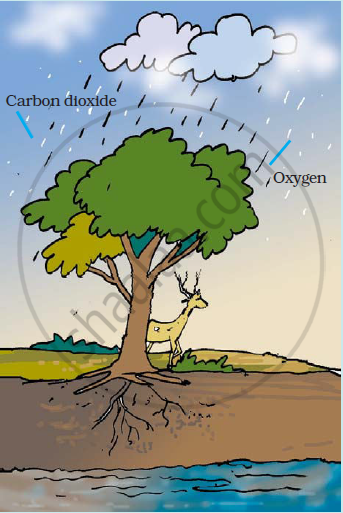Advertisements
Chapters
2: Nutrition in Animals
3: Heat
4: Acids, Bases and Salts
5: Physical and Chemical Changes
6: Respiration in Organisms
7: Transportation in Animals and Plants
8: Reproduction in Plants
9: Motion and Time
10: Electric Current and Its Effects
11: Light
▶ 12: Forests: Our Lifeline
13: Wastewater Story
![NCERT solutions for Science [English] Class 7 chapter 12 - Forests: Our Lifeline NCERT solutions for Science [English] Class 7 chapter 12 - Forests: Our Lifeline - Shaalaa.com](/images/science-english-class-7_6:325736d0fe154a27901a6745284d30d9.jpg)
Advertisements
Solutions for Chapter 12: Forests: Our Lifeline
Below listed, you can find solutions for Chapter 12 of CBSE NCERT for Science [English] Class 7.
NCERT solutions for Science [English] Class 7 12 Forests: Our Lifeline Exercises [Pages 153 - 155]
Explain how animals dwelling in the forest help it grow and regenerate.
Explain how forests prevent floods.
What are decomposers?
Name any two of the decomposers.
What do decomposers do in the forest?
Explain the role of forest in maintaining the balance between oxygen and carbon dioxide in the atmosphere.
Explain why there is no waste in a forest.
List five products we get from forests.
Fill in the blanks:
The insects, butterflies, honeybees and birds help flowering plants in ______.
A forest is a purifier of ______ and ______.
Herbs form the ______ layer in the forest.
The decaying leaves and animal droppings in a forest enrich the ______.
Why should we worry about the conditions and issues related to forests far from us?
Explain why there is a need of variety of animals and plants in a forest.
In the figure, the artist has forgotten to put the labels and directions on the arrows. Mark the directions on the arrows and label the diagram using the following labels:
clouds, rain, atmosphere, carbon dioxide, oxygen, plants, animals, soil, roots, water table.

Which of the following is not a forest product?
Gum
Plywood
Sealing wax
Kerosene
Which of the following statements is not correct?
Forests protect the soil from erosion.
Plants and animals in a forest are not dependent on one another.
Forests influence the climate and water cycle.
Soil helps forests to grow and regenerate.
Micro-organisms act upon the dead plants to produce.
sand
mushrooms
humus
wood
NCERT solutions for Science [English] Class 7 12 Forests: Our Lifeline Activities and Projects [Page 155]
Extended Learning — Activities and Projects
The Department of Environment is to decide whether some portion of a forest in your area could be cleared for a housing complex. Write a letter to the department explaining your point of view as a concerned citizen.
Visit a forest. Here is a list of points that would make your visit more fruitful.
- Make sure that you have permission to go into the forest.
- Make sure that you can find your way around. Get a map and go along with someone who is familiar with the area.
- Keep a record of the things you see and do. Observations make the visit interesting. Sketches and photographs are useful.
- You may record bird calls.
- Collect different kinds of seeds or hard fruits like nuts.
- Try to recognise various types of trees, shrubs, herbs, etc. Make lists of plants from different places in the forest and of different layers. You may not be able to name all the plants, but it is worth recording and seeing where they grow. Make a record of approximate heights of plants, crown shape, bark texture, leaf size, and flower colour.
- Learn to recognise the animal’s droppings.
- Interview the forest officials and the people of surrounding villages and other visitors.
You must never collect birds’ eggs, and their nests should never be disturbed.
You can read more on the following website:
Solutions for 12: Forests: Our Lifeline
![NCERT solutions for Science [English] Class 7 chapter 12 - Forests: Our Lifeline NCERT solutions for Science [English] Class 7 chapter 12 - Forests: Our Lifeline - Shaalaa.com](/images/science-english-class-7_6:325736d0fe154a27901a6745284d30d9.jpg)
NCERT solutions for Science [English] Class 7 chapter 12 - Forests: Our Lifeline
Shaalaa.com has the CBSE Mathematics Science [English] Class 7 CBSE solutions in a manner that help students grasp basic concepts better and faster. The detailed, step-by-step solutions will help you understand the concepts better and clarify any confusion. NCERT solutions for Mathematics Science [English] Class 7 CBSE 12 (Forests: Our Lifeline) include all questions with answers and detailed explanations. This will clear students' doubts about questions and improve their application skills while preparing for board exams.
Further, we at Shaalaa.com provide such solutions so students can prepare for written exams. NCERT textbook solutions can be a core help for self-study and provide excellent self-help guidance for students.
Concepts covered in Science [English] Class 7 chapter 12 Forests: Our Lifeline are Forests: Our Lifeline, Forest Biome, Habitat, Structure and Function of an Ecosystem, Biogeochemical Cycle, The Oxygen Cycle, Water Cycle, The Carbon Cycle, Importance of Forest, Deforestation and Its Causes, Consequences of Deforestation, Classification of Plants, Forests: Our Lifeline, Forest Biome, Habitat, Structure and Function of an Ecosystem, Biogeochemical Cycle, The Oxygen Cycle, Water Cycle, The Carbon Cycle, Importance of Forest, Deforestation and Its Causes, Consequences of Deforestation, Classification of Plants.
Using NCERT Science [English] Class 7 solutions Forests: Our Lifeline exercise by students is an easy way to prepare for the exams, as they involve solutions arranged chapter-wise and also page-wise. The questions involved in NCERT Solutions are essential questions that can be asked in the final exam. Maximum CBSE Science [English] Class 7 students prefer NCERT Textbook Solutions to score more in exams.
Get the free view of Chapter 12, Forests: Our Lifeline Science [English] Class 7 additional questions for Mathematics Science [English] Class 7 CBSE, and you can use Shaalaa.com to keep it handy for your exam preparation.
